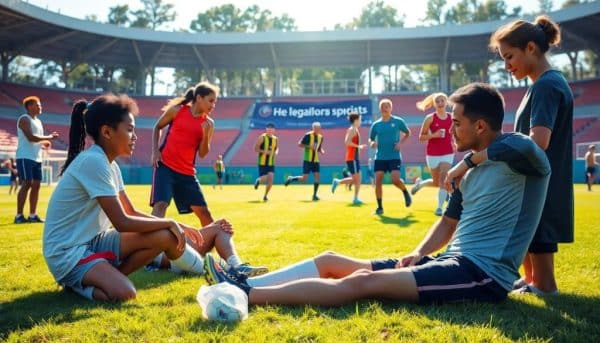Sports injuries are a significant concern for athletes of all ages. Understanding the sports injuries and legal responsibility is crucial for players, coaches, and organizations alike. This article explores essential aspects of liability in sports, focusing on negligence, common injuries, and legal implications.
What Is The Concept Of Liability In Sports Law?
Liability in sports law pertains to the responsibilities held by various parties when injuries occur. This concept is primarily focused on negligence, which involves failing to exercise reasonable care. Sports organizations, coaches, and trainers must adhere to certain standards to ensure athlete safety.
In the context of sports injuries and legal responsibility, liability can arise from several factors, including the conditions of play, insufficient training, and inadequate equipment. Understanding these elements is vital for mitigating risks associated with injuries.
For example, if a coach does not provide proper training that leads to an athlete's injury, they may be held liable. Therefore, establishing a clear understanding of liability is essential for all involved in sports.
How Do Sports Injuries Occur?
Sports injuries often occur due to a combination of factors, including improper training, accidents, and inadequate equipment. Common causes include:
- Faulty equipment that fails during use
- Unsafe playing conditions, such as wet or uneven surfaces
- Poorly designed training programs that do not consider individual athlete needs
The risk of injuries increases significantly when these factors are present. Athletes must also be aware of their physical limitations to prevent injury. Failure to heed warnings can lead to serious consequences.
In many cases, injuries happen as a result of a lack of supervision. Coaches and trainers play a crucial role in monitoring athletes and ensuring safety protocols are followed. Their negligence can have legal implications.
What Are The Common Types Of Sports Injuries?
Sports injuries can vary widely depending on the type of sport and the physical demands placed on athletes. Some common types include:
- Sprains and strains
- Fractures
- Concussions
- Achilles tendon injuries
- Shin splints
Each type of injury requires different management strategies and may have varying legal implications. For instance, concussions demand careful assessment and treatment to avoid long-term consequences.
Understanding the common types of injuries can help athletes and organizations implement necessary safety measures. This proactive approach can reduce liability and improve athlete safety.
Who Can Be Held Responsible For Sports Injuries?
Multiple parties can be held responsible for sports injuries, including:
- Coaches: They must ensure proper training and safety measures are adhered to.
- Trainers: Responsible for maintaining athlete health and fitness.
- Sports organizations: They set policies and procedures for safety.
- Schools: Duty to protect student-athletes through supervision and safety protocols.
Each of these parties has a legal obligation to provide a safe environment for athletes. Failure to meet these obligations can lead to significant legal repercussions.
In youth sports, the legal landscape shifts slightly, as parents may also have a role in ensuring safety. Understanding the intricacies of responsibility is crucial for preventing legal issues.
What Are The Legal Implications Of Sports Injuries?
The legal implications of sports injuries can vary widely based on the context and the individuals involved. Injuries can lead to sports injury claims where athletes seek compensation for damages. Factors affecting liability include:
- Assumption of risk: Athletes may accept certain risks inherent in the sport.
- Negligence: Establishing that a party failed to act in a reasonable manner.
- Duty of care: The obligation to protect athletes from harm.
Understanding these legal implications helps athletes and organizations prepare for potential injuries and navigate the complex legal landscape effectively.
Moreover, athletes injured during competition often face challenges in proving negligence. They must demonstrate that the responsible party failed to meet their duty of care.
How Is Negligence Established In Sports Injury Cases?
Establishing negligence in sports injury cases involves proving four essential elements:
- Duty: The responsible party owed a duty of care to the injured athlete.
- Breach: There was a failure to meet that duty of care.
- Causation: The breach directly caused the injury.
- Harm: The athlete suffered damages as a result.
For example, if a coach fails to recognize signs of a concussion, and the athlete suffers further harm, the coach may face legal action. This highlights the importance of proper training and adherence to safety standards.
Negligence claims can be complex, often requiring expert testimony to establish standards of care in sports settings. Engaging experienced legal counsel can enhance an athlete's chances of a successful claim.
What Steps Should You Take After A Sports Injury?
After a sports injury, it is vital to take specific steps to ensure proper recovery and protect your legal rights:
- Seek medical attention immediately to assess the severity of your injury.
- Document the incident thoroughly, including taking notes and gathering witness statements.
- Notify coaches or supervisors about the injury.
Following these steps can help establish a clear record of the injury and the circumstances surrounding it. This documentation is crucial if legal action becomes necessary.
Additionally, athletes should keep detailed records of medical treatments and expenses related to their injury. This information can be vital in any potential claims for damages.
Questions related to sports injuries and legal responsibility
What is the legal responsibility for an injury?
The legal responsibility for an injury typically lies with the party whose negligence led to the injury. In sports, this can include coaches, trainers, and organizations. They are expected to uphold a duty of care to protect athletes from harm. If they fail to do so, they may be held liable for any resulting injuries.
This responsibility also extends to ensuring that proper safety measures are in place, such as maintaining equipment and providing adequate training. When these standards are not met, legal action may follow.
Can you sue someone for injuring you in a sport?
Yes, you can sue someone for injuring you in a sport, provided you can demonstrate that their negligence caused your injury. This typically involves proving that they failed to uphold their duty of care, which led to your harm.
Legal claims can be complicated and often require substantial evidence, including medical records and eyewitness accounts. Consulting with an attorney experienced in sports injury claims can help clarify your options and guide you through the legal process.
Who is responsible for injuries in sports?
Responsibility for injuries in sports can fall on various parties, including coaches, trainers, and sporting organizations. Each of these entities has a duty to ensure a safe environment for athletes. If negligence occurs within any of these roles, they may be held liable for injuries sustained.
Additionally, in youth sports, parents may have some responsibility in ensuring children are participating in safe conditions. Understanding these complexities is crucial for navigating potential legal issues.
Who is responsible if a player gets injured?
If a player gets injured, liability can depend on the circumstances surrounding the injury. Coaches and trainers could be responsible if their negligence led to the injury. Similarly, sports organizations may hold some liability if safety protocols were not adequately enforced.
In recreational sports, players may assume certain risks; however, organizers still have a duty to mitigate hazards. Identifying the responsible party is essential for pursuing any legal action related to the injury.

